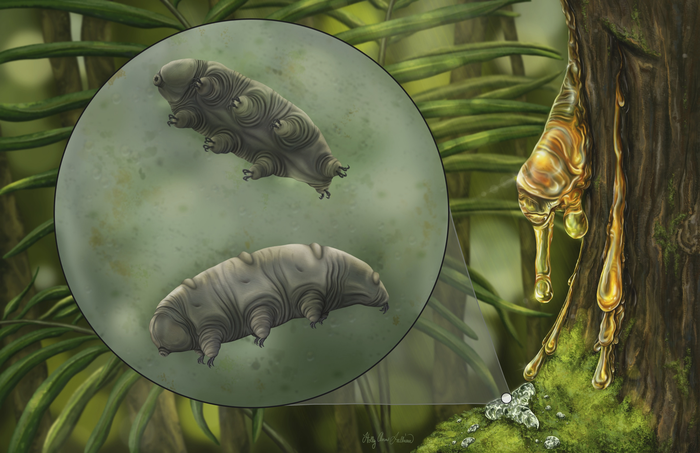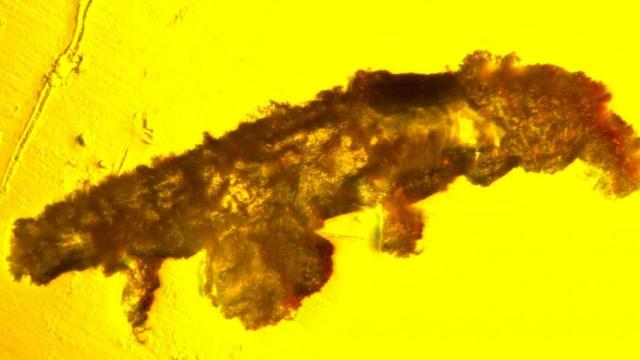Though it proved difficult to spot, scientists managed to find an itsy-bitsy tardigrade trapped inside a chunk of Dominican amber. The unprecedented discovery of an ancient tardigrade is shedding new light onto this remarkably durable group of microscopic animals.
Some 16 million years ago, a single plop of tree resin managed to capture a fragment from a flower, three ants, and a beetle. That’s an impressive haul, but more remarkably, the resin also trapped a wayward tardigrade. The resulting chunk of amber is only the third known tardigrade fossil and the first tardigrade fossil from the Cenozoic, the current era that began 66 million years ago with the extinction of all non-avian dinosaurs.
The fossil was found at La Cumbre in the Dominican Republic, an area known for its ample amber deposits. Researchers from the New Jersey Institute of Technology and Harvard University had already studied the piece of amber for months before they spotted the half-millimetre-long critter tucked away in a corner. In a press release, senior author Phil Barden described it as a “once-in-a-generation” discovery. Details of the finding now appear in the science journal Proceedings of the Royal Society B.

Tardigrades are among the hardiest creatures on Earth. The eight-legged invertebrates are known to shrug off the effects of extreme dehydration, bitterly cold temperatures, and damaging radiation. They can survive being shot out of a gun (to a point), and their walking skills rival those of creatures 500,000 times their size. Tardigrades, also known as water bears and moss piglets, are ancient organisms, having appeared some 500 million years ago and surviving no fewer than five mass extinctions. Very few animals on Earth can claim such an impressive résumé.
“What is so remarkable is that tardigrades are a ubiquitous ancient lineage that has seen it all on Earth, from the fall of the dinosaurs to the rise of terrestrial colonisation of plants,” said Barden. “Yet, they are like a ghost lineage for paleontologists with almost no fossil record. Finding any tardigrade fossil remains is an exciting moment where we can empirically see their progression through Earth history.”
Analysis of the fossil revealed some distinct physical characteristics, warranting the declaration of a new species and genus. The tardigrade has been named Paradoryphoribius chronocaribbeus, which blends “chrono,” the Greek word for time, and “caribbeus,” for the region in which the fossil was found. The specimen is a relative of the modern living tardigrade superfamily Isohypsibioidea, according to the research.
The scientists say this is the best-imaged fossil tardigrade yet. The team was able to see some very fine details, including internal structures, mouthparts, and needle-like claws dozens of times finer than human hair.
For the first time ever, scientists managed to visualise the “internal anatomy of the foregut in a tardigrade fossil and found combinations of characters in this specimen that we don’t see in living organisms now,” Marc Mapalo, the lead author of the paper and a graduate student at Harvard’s Department of Organismic and Evolutionary Biology, said in the press release. “Not only does this allow us to place this tardigrade in a new genus, but we can now explore evolutionary changes this group of organisms experienced over millions of years.”
Barden said they’re still “scratching the surface” when it comes to understanding the evolutionary history of tardigrades. This is a rare find, but the discovery shows that scientists should look very carefully at even the tiniest specks when studying amber fossils.
